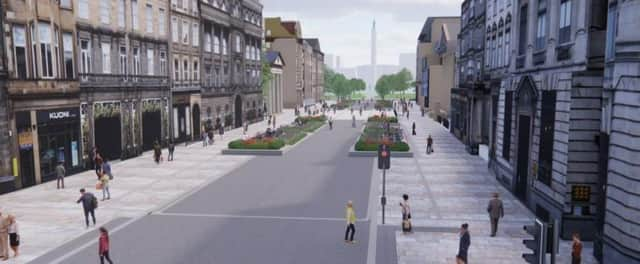Edinburgh’s Las Ramblas is a pleasing prospect but the devil is in the detail – and the cost: John McLellan


That may fill you with horror or excitement, but like Princes Street, the nature of George Street is already changing away from shopping because of the St James Quarter and the impact of online retailing.
Hamilton & Inches carries elegantly on, but there simply aren’t enough people with serious money to attract more shops selling the kind of luxury goods on offer in Harvey Nichols and Multrees Walk. A five-minute stroll through London’s St James or Belgravia is all you need to understand the difference.
Advertisement
Hide AdAdvertisement
Hide AdThe changes under discussion at today’s transport committee reflect the ongoing evolution of George Street from shopping to leisure, and although the proposals broadly represent a pragmatic attempt to balance competing demand ─ and the visualisations are unquestionably seductive ─ as always, the devil is in the detail.
On the plus side is the acceptance that bus access must be maintained on the North-South routes, like Frederick Street and Hanover Street, which looks very much like welcome confirmation that previous plans to ban buses from the city centre altogether are history.
It was always a nonsense to expect Lothian Buses to accept the break-up of previously efficient routes and then run free hopper buses to link up services which could go to, but not cross, central Edinburgh.
A ban on private cars and time-limited access for commercial access has been on the cards for years and feels inevitable, but at a current estimated cost of £36m for the whole scheme to accrue an estimated benefit to the Edinburgh economy of £95m over 20 years, there are legitimate questions to be asked about value for money and if that level of expense, and almost certainly more, is needed to achieve that return?
Advertisement
Hide AdAdvertisement
Hide AdIt's impossible to tell from the papers exactly how the budget is calculated, but a significant amount will be on the raised gardens and creating the right conditions for trees, including moving utilities which is always disruptive, unpredictable and expensive.
I’ve never shared fears that the introduction of trees would harm the World Heritage Site’s “universal values”, and I suspect a large majority would wonder what all the fuss was about when there are trees everywhere else. But if trees aren’t in keeping with the original New Town concept and will add significantly to the cost without making much difference to the return, why bother?
The removal of parking will undoubtedly be an inconvenience, although the cost for non-residents is now so exorbitant it’s becoming a luxury to be used only for absolute necessity. At least the council promises to commission a specialist accessibility consultant to look at provision for Blue Badge holders, but the effect of displacement on residents in the immediate area could be considerable.
Similarly, taxi access remains a problem. The number of cabs has exploded since the advent of Uber and a George Street ban will increase congestion elsewhere. And although taxis will get access after 7pm, there are legitimate concerns about the impact on the George Hotel’s guests.
All these issues need addressing and with a target of summer 2024 for completion of the next design stage there is a long way, and money, to go.
Comment Guidelines
National World encourages reader discussion on our stories. User feedback, insights and back-and-forth exchanges add a rich layer of context to reporting. Please review our Community Guidelines before commenting.